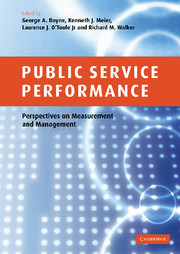Book contents
- Frontmatter
- Contents
- List of figures
- List of tables
- Notes on contributors
- 1 Introduction
- 2 Subjective and objective measures of organizational performance: An empirical exploration
- 3 All measures of performance are subjective: More evidence on US federal agencies
- 4 A qualitative evaluation of public sector organizations: Assessing organizational performance in healthcare
- 5 Quantitative approaches towards assessing organizational performance
- 6 Consequences of goal ambiguity in public organizations
- 7 Performance control and public organizations
- 8 Bureaucratic red tape and organizational performance: Testing the moderating role of culture and political support
- 9 All that glitters is not gold: Disaggregating networks and the impact on performance
- 10 Network evolution and performance under public contracting for mental health services
- 11 The design and management of performance-based contracts for public welfare services
- 12 Outsourcing government information technology services: An Australian case study
- 13 International comparisons of output and productivity in public service provision: A review
- 14 Public management and government performance: An international review
- 15 What drives global e-government? An exploratory assessment of existing e-government performance measures
- 16 Public management and organizational performance: An agenda for research
- Index
- References
8 - Bureaucratic red tape and organizational performance: Testing the moderating role of culture and political support
Published online by Cambridge University Press: 22 September 2009
- Frontmatter
- Contents
- List of figures
- List of tables
- Notes on contributors
- 1 Introduction
- 2 Subjective and objective measures of organizational performance: An empirical exploration
- 3 All measures of performance are subjective: More evidence on US federal agencies
- 4 A qualitative evaluation of public sector organizations: Assessing organizational performance in healthcare
- 5 Quantitative approaches towards assessing organizational performance
- 6 Consequences of goal ambiguity in public organizations
- 7 Performance control and public organizations
- 8 Bureaucratic red tape and organizational performance: Testing the moderating role of culture and political support
- 9 All that glitters is not gold: Disaggregating networks and the impact on performance
- 10 Network evolution and performance under public contracting for mental health services
- 11 The design and management of performance-based contracts for public welfare services
- 12 Outsourcing government information technology services: An Australian case study
- 13 International comparisons of output and productivity in public service provision: A review
- 14 Public management and government performance: An international review
- 15 What drives global e-government? An exploratory assessment of existing e-government performance measures
- 16 Public management and organizational performance: An agenda for research
- Index
- References
Summary
Introduction
This chapter examines the relationship between red tape and performance, and proposes that organizational culture and political support can mitigate the negative effects of red tape. Bureaucratic red tape is a concept that both holds widespread popular appeal and is one of the few ‘homegrown’ theories in the field of public management. Despite this, academic work on red tape has not informed public management changes, or even the broader public management literature. Developments on conceptualizing and measuring red tape (e.g., Bozeman 1993; Pandey and Scott 2002) have had little direct influence on the thinking of reformers who seek to cut red tape (Gore 1993; Osborne and Gaebler 1992), or even the academic discussion of these reforms (e.g., Ingraham et al. 1997; Kettl and DiIulio 1995). While most scholars would probably accept the argument that red tape matters to performance, the recent emergence of an empirical literature on public sector performance also largely excludes explicit consideration of red tape (Ingraham et al. 2003; Lynn et al. 2001; O'Toole and Meier 1999).
Red tape, therefore, is an area of public management in which theoretical developments and practical concerns are pulling in different directions. For example, when Vice-President Gore discussed moving from red tape to results during the 1990s, he drew neither on groundbreaking theoretical work by Bozeman (1993) nor on Kaufman's (1977) seminal work. Such separation between theory and practice benefits neither enterprise.
- Type
- Chapter
- Information
- Public Service PerformancePerspectives on Measurement and Management, pp. 130 - 151Publisher: Cambridge University PressPrint publication year: 2006
References
- 35
- Cited by



